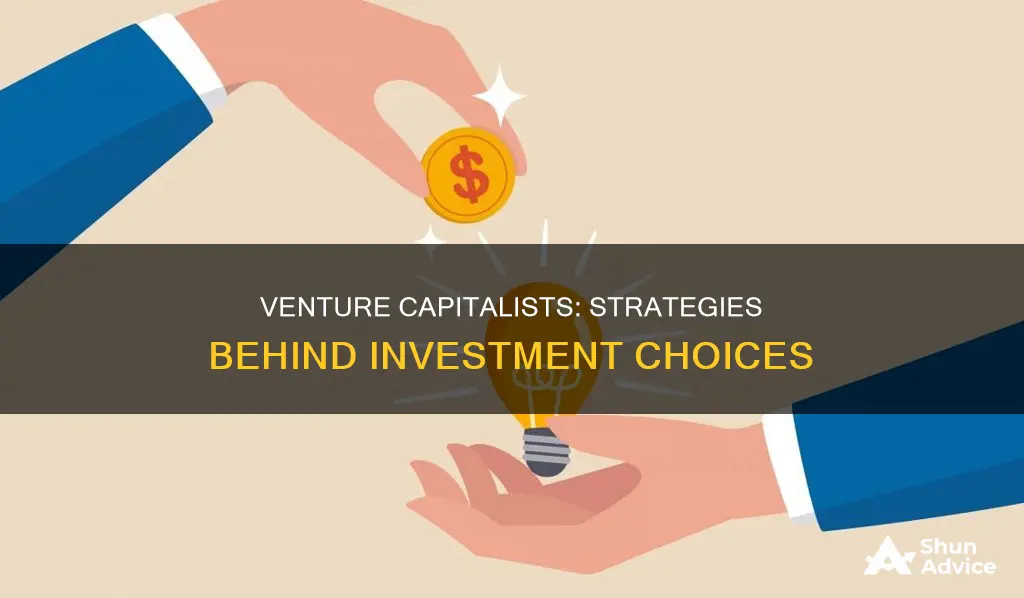
Venture capitalists (VCs) play a crucial role in the economy by financing high-growth start-ups. However, little is known about their decision-making processes and how they create value. VCs take on significant risks by investing in new start-up companies, hoping to find the next big success story. With so many investment opportunities, they use a set of criteria to evaluate potential investments, including the management team, business concept, market opportunity, and risk judgement. The management team is often considered the most important factor, as VCs invest in the team's ability to execute the business plan. VCs also consider the business model, product or service, and its market fit, as well as the internal rate of return to estimate profitability. They aim to balance risk and reward, minimising risk while achieving substantial returns. Understanding these factors is essential for entrepreneurs seeking venture capital investment.
| Characteristics | Values |
|---|---|
| Management team | The most important factor in investment decisions |
| Business-related factors | Business model, product or service, and market fit |
| Internal rate of return | A metric to estimate profitability |
| Deal sourcing | The ability to generate a pipeline of high-quality investment opportunities |
| Deal selection | The most important factor in value creation |
| Post-investment value-added | Strategic guidance, connecting investors and customers, operational guidance, hiring board members and employees |
What You'll Learn

Management team
The management team is the most important factor venture capitalists (VCs) consider when deciding whether to invest in a company. They are not looking for inexperienced managers, but rather for executives who have successfully built businesses that have generated high returns for investors.
VCs invest in a management team and its ability to execute the business plan. Businesses looking for VC investment should be able to provide a list of experienced, qualified people who will play central roles in the company's development. If the business lacks talented managers, it should be willing to hire them from outside. VCs would rather invest in a bad idea led by accomplished management than a great business plan supported by a team of inexperienced managers.
When evaluating the management team, VCs look for industry expertise, a proven track record, leadership and cohesion, and vision and passion. They want to see that the team knows their business inside out and has the ability to lead, adapt, and drive growth.
In addition to evaluating the management team, VCs also consider other factors such as the business concept and plan, market opportunity, and risk judgement. They look for companies with a strong management team, a large potential market, and a distinctive product or service with a solid competitive advantage.
Investment Decisions: How Firms Strategize Their Capital
You may want to see also

Business-related factors
Founders seeking VC investment must be able to explain how their startup will generate revenue. VCs want to be assured that the company will be marketable and profitable, given the financial risks they are taking by investing in early-stage ventures. It is crucial for founders to be precise, clear, and transparent about their startup's strategy and current indicators when presenting to potential investors.
The business model is a critical aspect of the evaluation. VCs want to understand how the startup intends to create value and generate sales. They look for a sustainable business model that can lead to high returns on their investment. The product or service being offered should address a real problem or need in the market and provide a competitive edge. VCs seek investments with long-lasting competitive advantages that can generate sales and profits before competitors enter the market.
Market fit is another essential consideration. VCs want to invest in companies that target large, addressable markets with the potential to generate significant revenue. They typically define "large" as a market capable of generating $1 billion or more in revenue. VCs expect detailed market size analysis, including third-party estimates and customer feedback, to ensure that the startup's product or service has strong market demand.
Developing Leaders: Management Training for Future Success
You may want to see also

Internal rate of return
When deciding whether to invest in a startup, venture capitalists (VCs) have a set of criteria that they evaluate. One of the most important metrics they consider is the internal rate of return (IRR). IRR is a metric that helps estimate the profitability of a potential investment. It is the discount rate that makes the net present value (NPV) of an investment's cash flow stream equal to zero.
A project may be considered a good investment if its IRR is greater than the rate of return that could be earned by alternative investments of equal risk. VCs will often compare the IRR of a potential investment to a hurdle rate, which is the minimum required return for an investment to be worthwhile. If the IRR is higher than the hurdle rate, the project may be a good investment opportunity.
To calculate IRR, VCs need to determine their ownership stake in the company post-investment. This is done using a capitalization table (cap table) that divides the common share equivalents purchased by the VC by the total common share equivalents outstanding after the investment. The resulting percentage is then multiplied by the exit-year valuation to determine the VC's portion of the exit proceeds.
IRR is a complex metric that is influenced by various factors, including market momentum, the strength of the economy, a project's strategic positioning, business performance, and its level of debt and leverage. Disaggregating the components of IRR can help investors better understand the true value of an investment in light of its risk and expected returns.
In addition to IRR, VCs may also consider other metrics such as cash-on-cash return, which is calculated by dividing the proceeds received upon exiting an investment by the initial investment amount. By evaluating these metrics and considering the specific circumstances of each investment opportunity, VCs can make more informed decisions about where to allocate their capital.
Crafting the Perfect Investment Portfolio: Strategies for Success
You may want to see also

Risk judgement
When assessing risk, VCs consider potential regulatory or legal issues, the relevance of the product in the present and future markets, the availability of sufficient funds, and the potential for an exit and return on their investment. They aim to mitigate risks while pursuing substantial returns.
The management team plays a crucial role in risk judgement. VCs seek experienced and qualified managers with a track record of building successful businesses and generating high returns for investors. The competence and expertise of the management team are vital factors in the investment decision-making process.
Additionally, VCs assess the business-related factors, including the business model, product or service, and market fit. They want to ensure that the venture has a clear path to generating revenue, profitability, and marketability. A detailed market size analysis is essential, including third-party estimates and customer feedback.
Furthermore, VCs evaluate the competitive advantage of the business. They seek investments with a long-lasting competitive edge, offering unique solutions to burning problems in the marketplace. The presence of direct competitors is carefully considered, as it can impact the sales and profits of the venture.
In conclusion, risk judgement is a complex and crucial aspect of VC investment choices. By thoroughly evaluating the management team, business-related factors, market potential, and competitive landscape, VCs strive to make informed decisions that balance risk and return.
Private Equity Investment Strategies: Secrets to Success
You may want to see also

Market opportunity
To demonstrate market opportunity, startups should be able to provide a detailed market size analysis. This includes a "top-down" and "bottom-up" approach to market sizing. The former involves providing third-party estimates from market research reports, while the latter involves feedback from potential customers, indicating their willingness to buy and pay for the startup's product.
VCs also look for companies with a broad appeal and wide market prospects, rather than those hemmed into a niche market. They want to see a product with the potential to become indispensable, solving a problem that many companies or individuals encounter. The bigger the problem, the bigger the potential market share.
When assessing market opportunity, VCs will also consider the total addressable market (TAM), serviceable addressable market (SAM), and serviceable obtainable market (SOM). TAM refers to the overall revenue opportunity or demand for the product or service. SAM is the segment of the TAM targeted by the products or services within geographical reach. SOM is the portion of the SAM that can be captured.
In addition to market size and appeal, VCs also consider the growth prospects of the market. Economies showing robust growth rates are typically more attractive to VCs. They also look for markets with high R&D expenditure, as these are seen as better positioned for innovation and value creation.
Adjusting Your Investment Portfolio: Strategies for Success
You may want to see also
Frequently asked questions
The management team is the most important factor for VCs when deciding to invest. They look for a team with relevant experience and a track record of success. Other factors include the business model, product or service, market opportunity, and risk assessment.
VCs use various metrics to evaluate potential returns, including the internal rate of return (IRR) and cash-on-cash return. They also consider the size of the market opportunity and the competitive advantage of the product or service.
VCs use mental models based on their past experiences with similar deals and entrepreneurs. They compare new investment opportunities with these past templates to make decisions. Logic and intuition play a significant role when VCs encounter companies from sectors they have no experience in.
VCs generate potential investment deals through their professional networks, referrals from other investors or existing portfolio companies, and proactive self-generation. Only a small percentage of deals come inbound from company management.







